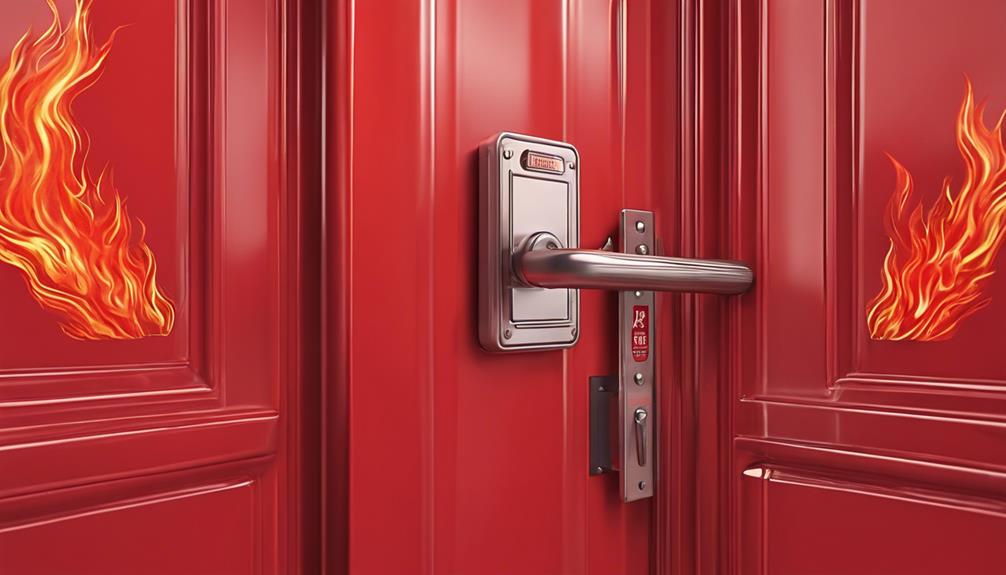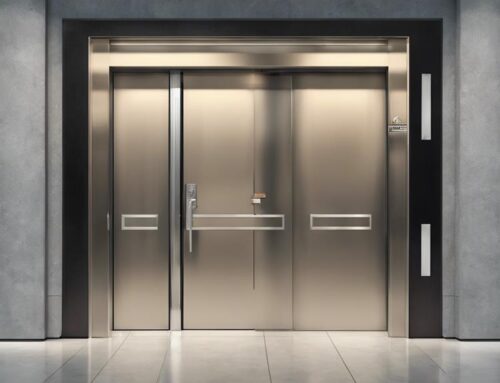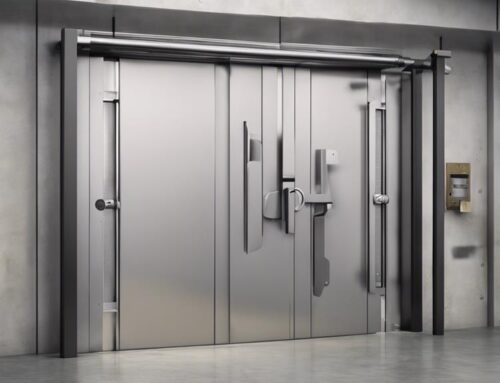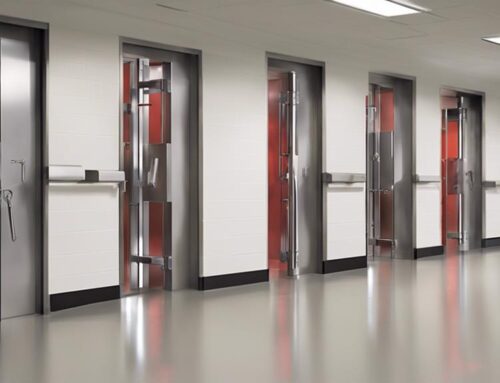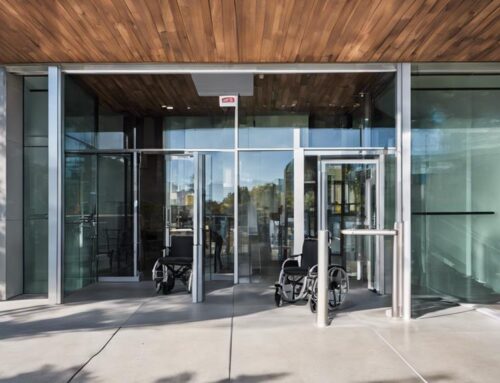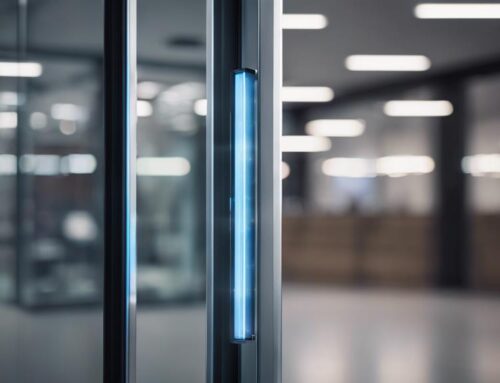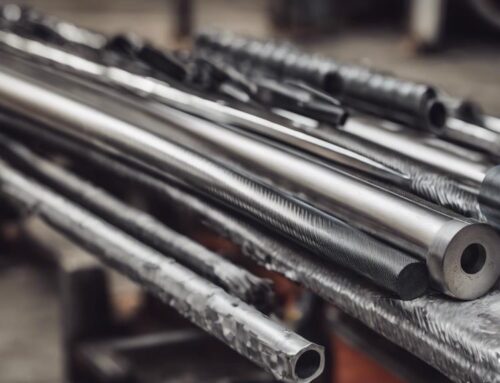Panic bars are essential in fire safety, ensuring swift and safe exits from commercial buildings during emergencies. You'll need to install them on all designated exit doors, ensuring they comply with local building codes and regulations like the IBC, which mandates their use for spaces with over 50 occupants. These bars should be installed at a height of 34-48 inches and require no more than 15 pounds of force to operate. Regular inspections and monthly tests are important for maintaining their functionality. Learn more about integrating these devices with fire safety systems to enhance overall protection.
Key Takeaways
- Panic bars are mandatory on exit doors in assembly and educational occupancies with 100+ occupants, ensuring quick and safe evacuation.
- Panic bars must be installed at a height of 34-48 inches for accessibility and ease of use.
- Monthly tests and annual inspections by qualified personnel are required to maintain panic bar functionality and compliance.
- Properly installed panic bars open automatically with fire alarms, enhancing evacuation efficiency.
- Professional installation ensures compliance with safety standards and reduces the risk of malfunction during emergencies.
Fire Code Requirements
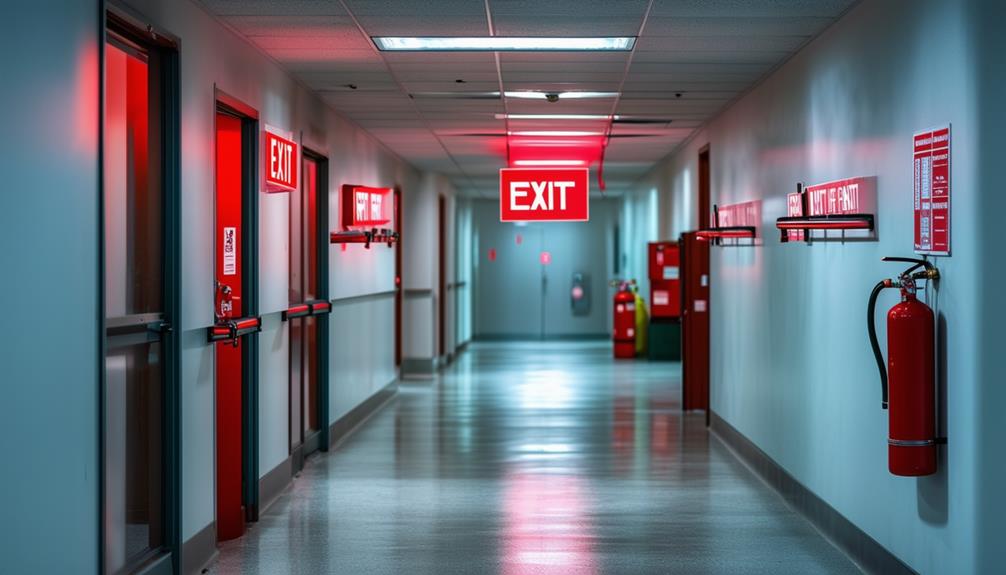
How do fire code requirements shape the installation of panic hardware in various buildings? Fire code compliance is essential when installing panic bars, especially in high-occupancy environments. According to the NFPA 101: Life Safety Code, panic hardware must be installed on exit doors in assembly and educational occupancies with 100 or more occupants and in high hazard occupancies with six or more occupants. Building codes like the IBC lower this threshold to 50 occupants for assembly and educational spaces, emphasizing the significance of safe egress in densely populated areas. Additionally, guaranteeing ADA compliance for panic bars is important to meet both safety and accessibility standards.
Panic bars must be mounted at a height between 34 to 48 inches above the floor, making them accessible to most individuals. The force required to operate these devices shouldn't exceed 15 pounds, making it easy for people of various physical capabilities to use them in emergencies. For fire-rated doors, fire exit hardware is mandatory, and additional locking devices that could hinder egress are generally prohibited unless they meet specific exceptions.
Regular inspections and maintenance are crucial for guaranteeing these devices function correctly and meet local codes. By adhering to these requirements, you guarantee that panic bars effectively contribute to building safety during emergencies.
How Panic Bars Enhance Fire Safety
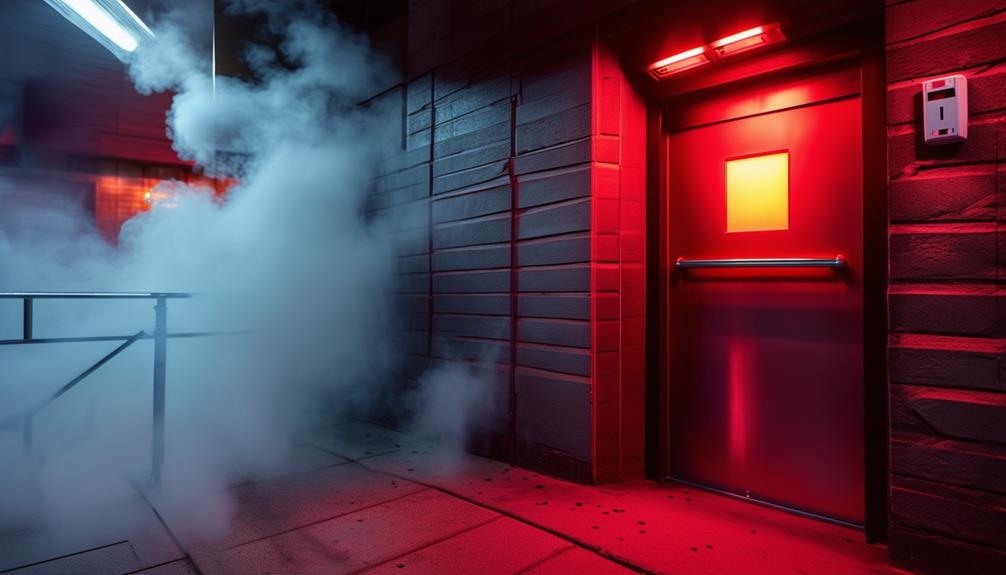
Panic bars greatly enhance fire safety by enabling rapid, unimpeded egress from buildings during emergencies. These devices allow people to exit quickly without needing keys or understanding complex mechanisms, which is essential in fire situations. Additionally, Low Rate Locksmith offers expert consultation services to guarantee your business selects the proper panic bar hardware and maintains compliance with fire safety regulations.
- Single-motion operation: Panic bars must be operable with just one motion and minimal effort, according to NFPA 101: Life Safety Code. This guarantees everyone, including those with disabilities, can easily use them.
- Regular maintenance: Monthly testing and annual inspections by qualified personnel are recommended to confirm panic bars are functional during emergencies. This regular upkeep aligns with NFPA standards, enhancing reliability.
- Proper installation: Installing panic bars on outward-swinging exit doors with a clear opening width of at least 32 inches is critical for efficient evacuation. This setup guarantees that evacuation routes are safe and effective.
Using panic bars not only complies with safety regulations but also minimizes legal liabilities. Documentation of inspections and maintenance fortifies your organization's safety culture, guaranteeing that these essential components are ready to perform as expected in emergencies. By focusing on these aspects, you confirm that your building's egress system remains up to code and, more importantly, ready to protect lives.
Panic Bars in Fire Drills

Building on the importance of proper installation and maintenance of panic bars, incorporating these devices into regular fire drills is just as vital. Panic bars are designed for quick, one-handed operation, allowing occupants to exit efficiently during emergencies without needing special knowledge. By integrating panic bars into your fire drills, you guarantee that everyone is familiar with their operation, which is essential for a rapid and safe evacuation.
Per NFPA guidelines, panic bars should be installed on outward-swinging doors, providing clear egress paths. During fire drills, verify that these bars are unobstructed and functioning correctly. Any malfunction can greatly hinder safe evacuation, so it's important to test their operation thoroughly. Additionally, routine maintenance can prevent unexpected failures. Services like Low Rate Locksmith's 24/7 nationwide mobile locksmith can confirm your panic bars are always in top condition.
Additionally, coordinating panic bars with your fire alarm systems guarantees a seamless evacuation process. When the fire alarm systems activate, occupants should automatically know to use the panic bars to exit. After each drill, document outcomes including the effectiveness of panic bar usage. This documentation helps identify areas needing improvement, enhancing your emergency preparedness.
Installation for Fire Safety
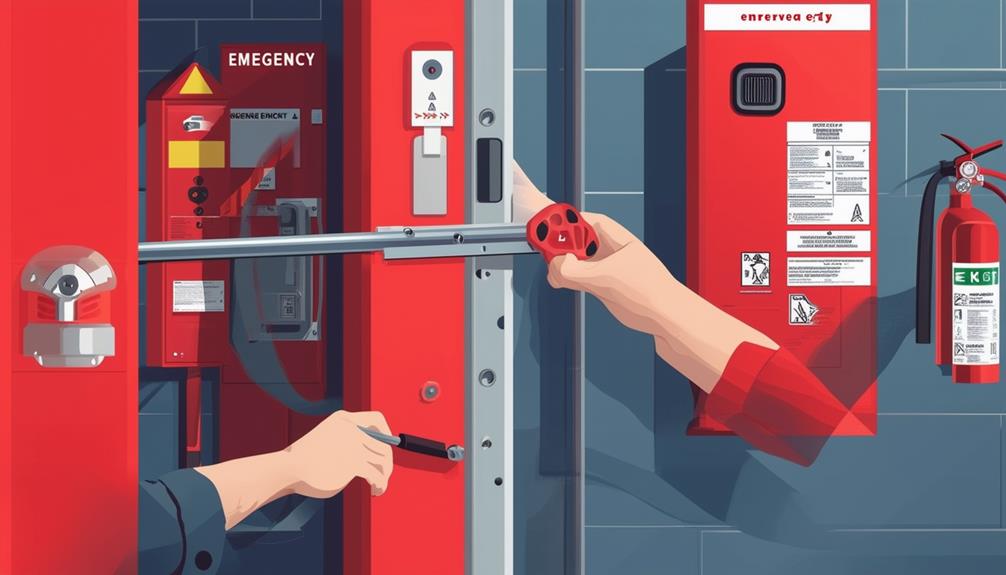
When installing panic bars for fire safety, guaranteeing compliance with both NFPA guidelines and local building codes is essential. You'll need to start by making certain that the exit doors swing outward, providing a minimum clear opening width of 32 inches. This facilitates quick egress during emergencies and meets fundamental fire safety regulations for panic bars. Panic bars should be mounted between 34 to 48 inches above the floor. This height guarantees accessibility for all users, including those with disabilities. Additionally, the installation must follow the manufacturer's guidelines and local building codes, which may impose extra requirements beyond NFPA standards.
Ascertain that the panic bars are at least 15 inches away from any adjacent walls. This placement prevents obstructions during operation, allowing for an immediate exit in emergency situations. Regular inspections and maintenance are also vital. Monthly testing and annual evaluations by qualified personnel verify that the panic bars are functional and compliant with safety regulations.
- Swing Direction: Exit doors must swing outward.
- Height Requirement: Mount bars 34-48 inches above the floor.
- Clearance: Position bars at least 15 inches from adjacent walls.
Testing Panic Bars for Fire Safety
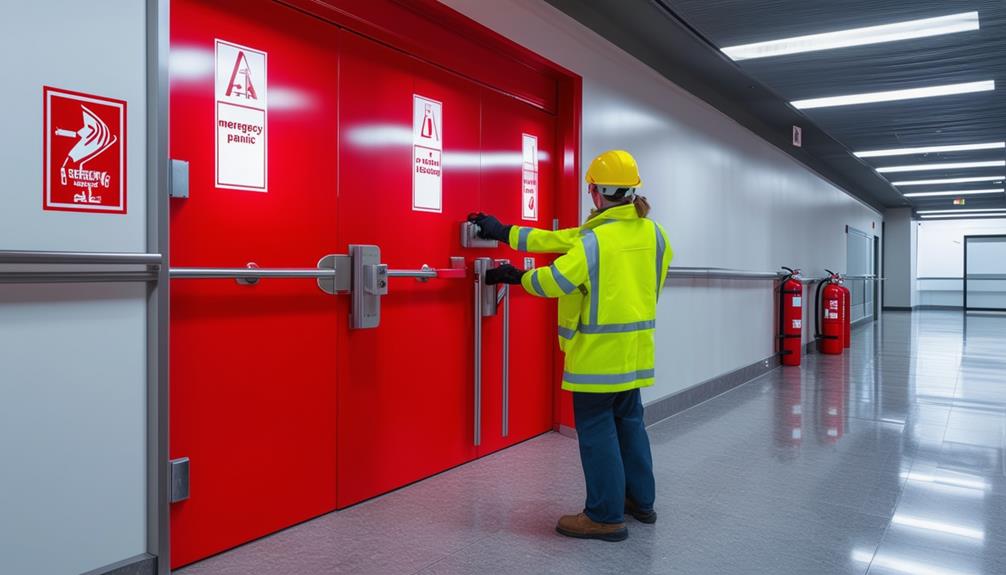
Guaranteeing the reliability of panic bars in emergency situations requires rigorous and regular testing to comply with safety standards like ANSI/BHMA. You need to conduct monthly panic bar fire safety inspections to identify any mechanical issues or obstructions. This routine check is essential for confirming the functionality of these devices, which must operate flawlessly under fire conditions and high-frequency use.
Documentation is critical for compliance with NFPA standards. By keeping detailed records of your inspections and any necessary repairs, you're minimizing risks during emergencies. Panic bars installed on fire-rated doors have to meet specific regulations, such as the prohibition of mechanical dogging and the requirement for fire exit hardware. These measures guarantee that the panic bars will function correctly when you need them most.
Testing protocols can vary by jurisdiction, so always adhere to local codes and manufacturer certifications. This guarantees that the panic bars are properly installed and maintained for fire safety.
| Inspection Task | Frequency | Compliance Standard |
|---|---|---|
| Mechanical Check | Monthly | ANSI/BHMA |
| Obstruction Removal | Monthly | NFPA |
| Documentation of Inspections | Ongoing | NFPA |
| Fire Exit Hardware Verification | Annually | Local Codes |
Common Fire Safety Mistakes
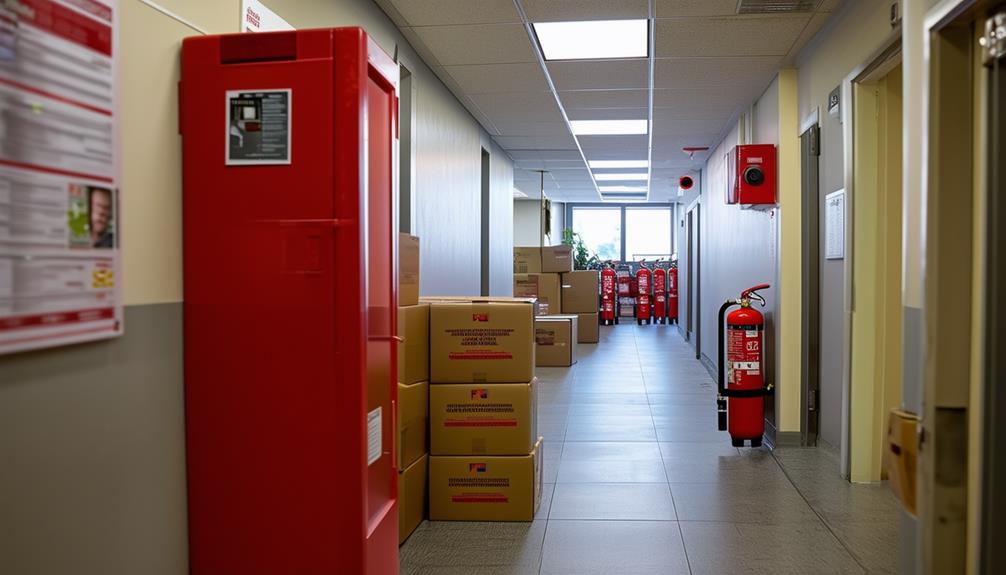
One of the most frequent fire safety mistakes is neglecting regular inspections and maintenance of panic bars, which can lead to disastrous malfunctions during emergencies. The NFPA recommends monthly testing and annual inspections by qualified personnel. Without this, you risk the panic bars failing when they're needed most. Additionally, it's essential to follow detailed instructions for installation to guarantee they function correctly during an emergency.
Using a panic bar fire safety checklist can help you avoid other common mistakes:
- Failing to comply with mounting height regulations. Panic bars should be installed between 34 to 48 inches above the floor to guarantee accessibility.
- Obstructing egress paths. Ensure a clear opening width of at least 32 inches for exit doors equipped with panic hardware.
- Assuming panic bars aren't necessary for buildings with fewer than 60 occupants. Certain occupancy types may still require them according to local building codes.
Additionally, don't forget the importance of training staff on the operation of panic bars. This training can prevent confusion and delays during an emergency, enhancing evacuation effectiveness. Regularly reviewing your panic bar fire safety checklist and addressing these common issues can greatly improve your building's fire safety. Make sure your facility is prepared and compliant to guarantee the safety of everyone inside.
Case Studies on Panic Bars and Fire Safety

Panic bars have proven to be life-saving mechanisms in numerous emergency scenarios, providing swift and efficient egress. In several case studies, the installation of panic bars has been directly linked to reduced evacuation times and lower casualty rates during fires. For instance, historical incidents show that buildings equipped with panic bars that meet NFPA 101 standards—requiring easy, one-handed operation—enabled faster and safer evacuations. These devices are often compared to other exit mechanisms to highlight their effectiveness in emergency situations.
In one study, a public building with panic bar fire safety solutions experienced markedly fewer casualties during a fire. The panic bars reduced bottlenecks at emergency exits, allowing occupants to exit quickly. Monthly functionality tests and annual inspections, as recommended by NFPA guidelines, were essential in maintaining these devices' reliability.
Moreover, compliance with panic bar regulations can mitigate legal liabilities for building owners. Non-compliance often results in hefty fines and increased risks during emergencies. By ensuring that panic bars are regularly inspected and maintained, you not only enhance your building's safety but also adhere to vital safety standards.
These case studies underscore the importance of panic bars in fire safety solutions, demonstrating their role in saving lives and improving overall emergency response efficacy.
Fire Safety Training for Building Staff
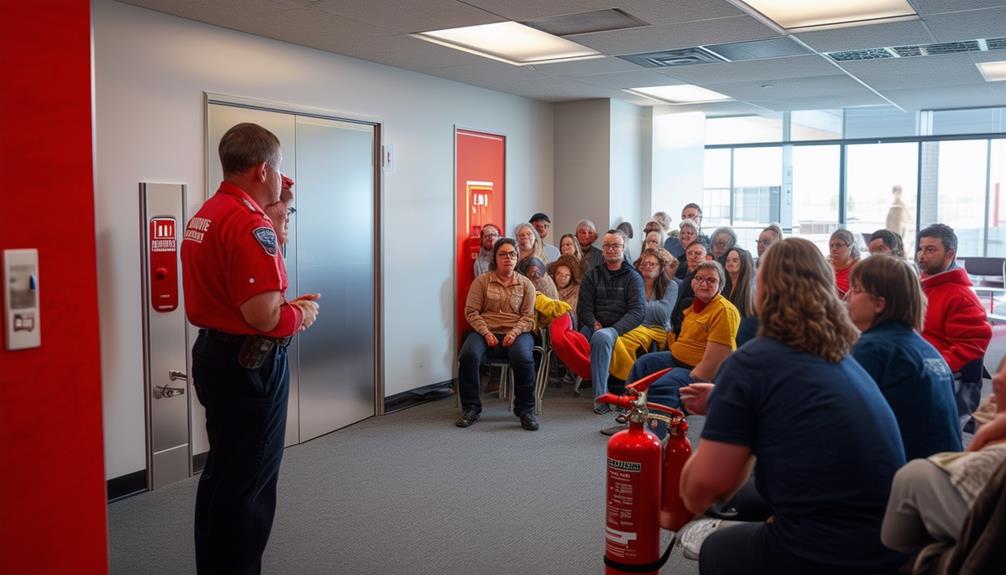
Understanding the role of panic bars in emergency scenarios is just one aspect of thorough fire safety. Equally important is training your building staff to handle these situations effectively. Your team needs to be well-versed in the functionality and operation of panic bars, enabling them to assist occupants swiftly and safely during emergencies. Additionally, familiarize them with the different types of panic bars available to guarantee they can identify and operate each correctly.
Training should include:
- Regular drills: Conduct frequent evacuation drills that focus on using panic bars to improve response times.
- Clear egress paths: Stress the importance of keeping exit routes unobstructed to guarantee swift access to panic bars.
- Routine inspections and maintenance: Emphasize the need for regular checks to confirm the reliability of panic bars and compliance with safety standards.
During training, highlight the necessity of routine inspections and maintenance of panic bars to assure their effectiveness. Educate your staff on local fire codes and regulations concerning panic bar installation and operation. This knowledge guarantees compliance and enhances overall fire safety. By incorporating these elements into your fire safety training, you'll equip your staff with the expertise needed to manage emergency situations efficiently, maintaining a safe environment for everyone.
Integrating Panic Bars with Fire Alarms
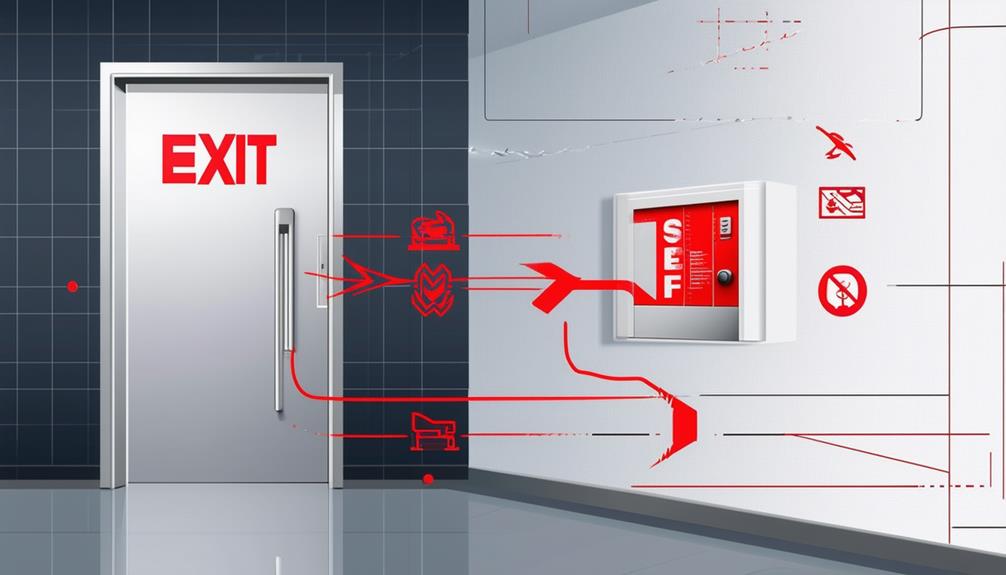
Integrating panic bars with fire alarms is a significant step in enhancing building safety during emergencies. When a fire alarm is activated, exit doors equipped with panic bars for fire exits should open automatically, allowing for a swift and unobstructed evacuation. This integration guarantees that no one is delayed by locked doors when every second counts.
Panic bars must be installed to guarantee clear access to emergency exits, especially in areas where fire alarms are likely to signal an urgent need for egress. Fire alarm systems can be designed to interface with panic bars, triggering them to release from a locked position, thereby eliminating any potential delays.
Regular testing of this integration is essential. By checking that both systems work together seamlessly, you can confirm they'll function properly when an emergency arises. Compliance with NFPA standards is mandatory, reinforcing the need for clear exit pathways in fire emergencies.
Here's a quick comparison to help you understand the integration:
| Aspect | Panic Bars | Fire Alarms |
|---|---|---|
| Primary Function | Open doors for emergency exits | Detect and signal fire emergencies |
| Integration Benefit | Rapid evacuation | Auto-release of panic bars |
| Installation Requirement | Unobstructed access | Interface capability with panic bars |
| Testing Frequency | Regularly for system checks | Regularly for system checks |
| Compliance Standard | NFPA standards | NFPA standards |
This integration is essential for a cohesive life safety system.
Compliance with Fire Safety Regulations
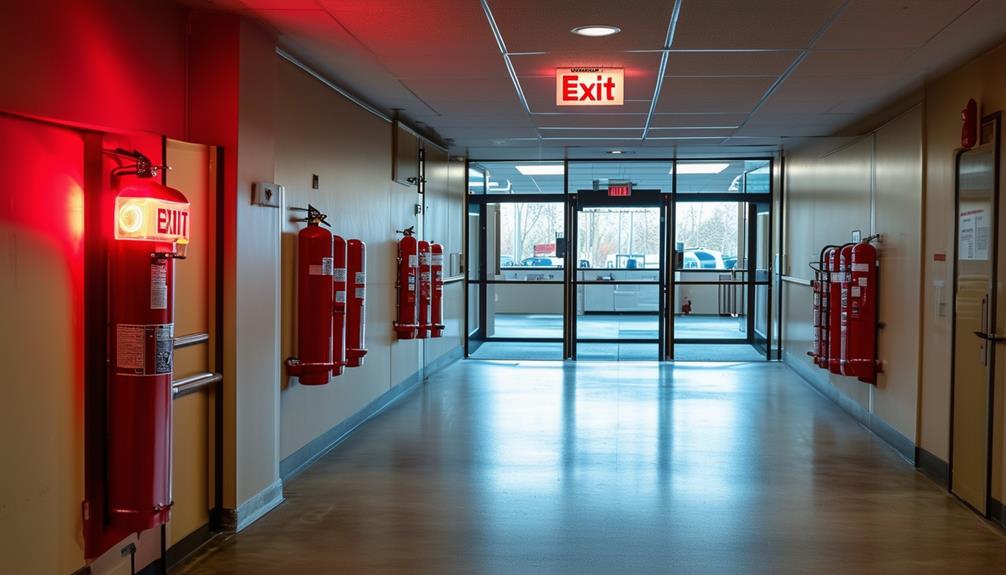
Guaranteeing that panic bars are effectively integrated with fire alarms is just one part of an all-encompassing fire safety strategy. Adhering to panic bar fire safety standards is essential for compliance with regulations like the NFPA 101: Life Safety Code. You need to guarantee that panic bars are installed on all designated exit doors in commercial buildings. This facilitates safe and efficient egress during emergencies.
To comply with fire safety regulations, pay attention to the following:
- Height Installation: Panic bars must be installed between 34 to 48 inches above the floor, guaranteeing accessibility for all users.
- Ease of Use: These bars must not require tight grasping, twisting, or pinching, making them usable for individuals with varying physical abilities.
- Regular Maintenance: Conduct monthly tests and annual inspections to confirm functionality and adhere to NFPA standards. For added assurance, consider utilizing affordable compliance inspections from reputable services like Low Rate Locksmith.
Non-compliance can lead to legal liabilities and fines, not to mention increased risks during emergencies. Regular inspections and maintenance are essential to guarantee that your panic bars are always up to code. Following these guidelines will help you guarantee that your facility meets all necessary panic bar fire safety standards, thereby safeguarding lives and protecting your business from potential legal repercussions.
Enhancing Fire Safety: Low Rate Locksmith's Panic Bar Installations
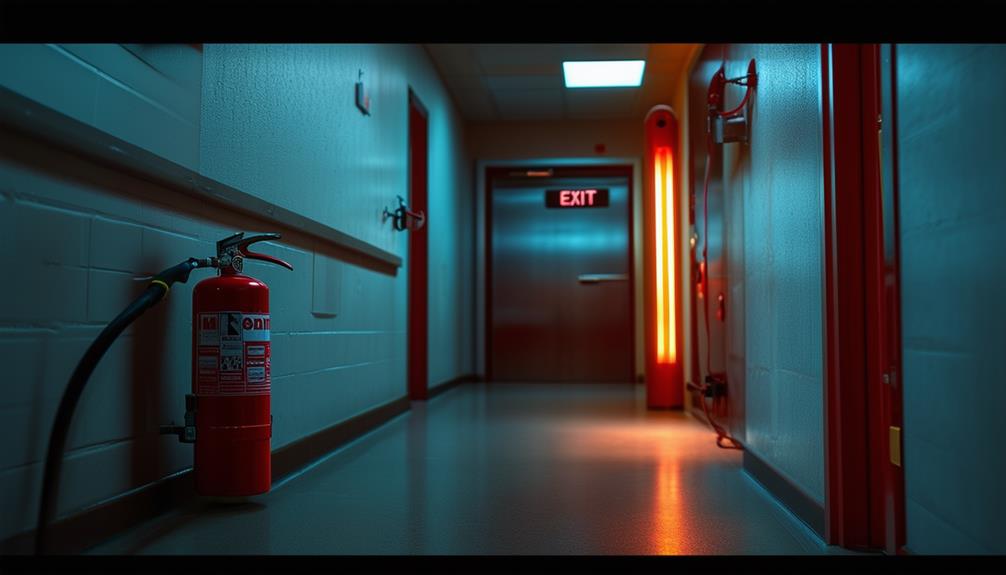
How can you guarantee high-quality fire safety in your commercial building? Start by making certain the installation of fire-rated panic bars by Low Rate Locksmith. These panic bars comply with NFPA 101: Life Safety Code, providing quick and safe egress during emergencies. Proper installation is essential; panic bars need to be positioned between 34 to 48 inches above the floor to be accessible to everyone, including individuals with disabilities.
Low Rate Locksmith guarantees these devices are installed at least 15 inches away from adjacent walls, maintaining a clear opening width of at least 32 inches. This ensures unimpeded escape routes, which are critical in an emergency. Their experienced technicians have specialized training to guarantee secure installation practices and use top-quality materials. Regular inspections and maintenance are fundamental to keep these systems functional. Monthly testing and annual inspections by qualified personnel are recommended to guarantee compliance and functionality.
Non-compliance with panic bar regulations can lead to fines and increased legal liability, making proper installation and maintenance of utmost importance. With Low Rate Locksmith, you can trust that every fire-rated panic bar meets stringent safety standards, enhancing the overall fire safety of your commercial building. Don't leave your building's safety to chance—opt for professional installation and regular upkeep.
Frequently Asked Questions
What Are the Code Requirements for Panic Bars?
You need to follow specific code requirements for panic bars. NFPA 101 requires them for assembly and educational occupancies with 100+ occupants and high hazard occupancies with 6+. The IBC mandates them for spaces with 50+ people. Actuating devices must span at least half the door's width and be 34-48 inches from the floor. The latch should release with no more than 15 pounds of force, sometimes just 5 pounds.
What Are the ADA Requirements for Panic Bars?
You need to guarantee ADA compliance for panic bars by installing them between 34 to 48 inches above the floor. They should operate without tight grasping, twisting, or pinching, and must allow a clear opening width of at least 32 inches. Panic bars should be operable with one hand and require minimal effort. Regular maintenance and inspections are essential to keep them functional and accessible, meeting both NFPA and ADA standards.
Does a Fire Door Need a Panic Bar?
Yes, a fire door needs a panic bar if it serves as an exit in assembly, educational, or high hazard occupancies with a high occupant load. The NFPA 101 and IBC mandate panic hardware for these scenarios. The panic bar must be positioned between 34 to 48 inches above the floor and guarantee immediate egress without additional locking devices. Regular inspections are required to maintain compliance.
What Doors Need Panic Bars?
You need to install panic bars on exit doors in assembly, educational, and daycare occupancies with 100 or more occupants, per NFPA 101. The IBC requires them for assembly and educational spaces with over 50 occupants and all high hazard occupancies. Guarantee doors swing outward and have a minimum width of 32 inches for quick evacuation. Compliance with ANSI/BHMA standards is essential for fire-rated doors, prohibiting additional locking devices.
Conclusion
Imagine you're in a smoke-filled hallway, heart racing, and you reach for the door. The panic bar gives way effortlessly, guiding you to safety. That's the essence of effective fire safety. With detailed installation, rigorous testing, and thorough training, panic bars become your lifeline in emergencies. Integrating them seamlessly with fire alarms ensures swift evacuations. Trust Low Rate Locksmith's expertise to enhance your building's fire safety, keeping everyone secure when it matters most.

